NuSTAR OBSERVATION OF A TYPE I X-RAY BURST FROM GRS 1741.9-2853
Author(s)
Krivonos, Roman A.; Tomsick, John A.; Bachetti, Matteo; Boggs, Steven E.; Chakrabarty, Deepto; Christensen, Finn E.; Craig, William W.; Hailey, Charles J.; Harrison, Fiona A.; Hong, Jaesub; Mori, Kaya; Stern, Daniel; Zhang, William W.; Barriere, Nicolas M.; ... Show more Show less
DownloadBarriere-2015-NuSTAR observation o.pdf (831.5Kb)
PUBLISHER_POLICY
Publisher Policy
Article is made available in accordance with the publisher's policy and may be subject to US copyright law. Please refer to the publisher's site for terms of use.
Terms of use
Metadata
Show full item recordAbstract
We report on two NuSTAR observations of GRS 1741.9-2853, a faint neutron star (NS) low-mass X-ray binary burster located 10' away from the Galactic center. NuSTAR detected the source serendipitously as it was emerging from quiescence: its luminosity was 6 × 10[superscript 34] erg s[superscript –1] on 2013 July 31 and 5 × 10[superscript 35] erg s[superscript –1] in a second observation on 2013 August 3. A bright, 800 s long, H-triggered mixed H/He thermonuclear Type I burst with mild photospheric radius expansion (PRE) was present during the second observation. Assuming that the luminosity during the PRE was at the Eddington level, an H mass fraction X = 0.7 in the atmosphere, and an NS mass M = 1.4 M [subscript ☉], we determine a new lower limit on the distance for this source of 6.3 ± 0.5 kpc. Combining with previous upper limits, this places GRS 1741.9-2853 at a distance of 7 kpc. Energy independent (achromatic) variability is observed during the cooling of the NS, which could result from the disturbance of the inner accretion disk by the burst. The large dynamic range of this burst reveals a long power-law decay tail. We also detect, at a 95.6% confidence level (1.7σ), a narrow absorption line at 5.46 ± 0.10 keV during the PRE phase of the burst, reminiscent of the detection by Waki et al. We propose that the line, if real, is formed in the wind above the photosphere of the NS by a resonant Kα transition from H-like Cr gravitationally redshifted by a factor 1 + z = 1.09, corresponding to a radius range of 29.0-41.4 km for a mass range of 1.4-2.0 M [subscript ☉].
Date issued
2015-01Department
Massachusetts Institute of Technology. Department of Physics; MIT Kavli Institute for Astrophysics and Space ResearchJournal
The Astrophysical Journal
Publisher
IOP Publishing
Citation
Barriere, Nicolas M., Roman Krivonos, John A. Tomsick, Matteo Bachetti, Steven E. Boggs, Deepto Chakrabarty, Finn E. Christensen, et al. “NuSTAR OBSERVATION OF A TYPE I X-RAY BURST FROM GRS 1741.9-2853.” The Astrophysical Journal 799, no. 2 (January 21, 2015): 123. © 2015 The American Astronomical Society
Version: Final published version
ISSN
1538-4357
0004-637X